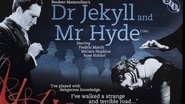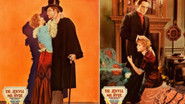JohnHowardReid
Nowadays it is extremely fashionable for critics to praise Mamoulian's version at the expense of Fleming's. After all, Mamoulian has a much higher status as an auteur than Fleming. Why? Fleming died in 1947 whereas Mamoulian was attending retrospectives and giving interviews well into the 1970s. Furthermore, his comparatively small body of work — 16 films over a 28-year period — makes the job of researching so much easier, leading to a proliferation of articles, theses and career studies. In addition, the 1931 version has attained a cult status due its purchase and subsequent suppression by MGM. (And no wonder they hid it away. Although Mahin receives sole screen credit, not only the adaptation — with its introduction of the Ivy character who is not present in Stevenson's line-up — but many of the scenes themselves are a direct steal.Despite the similarities, Mamoulian's is really a somewhat different film, looking at Hyde from a less moralistic angle. His direction is much more showy than Fleming's with its imaginative first-person camera and ingenious slow wipes. Both films have the benefit of no- expense-spared period sets and marvelously atmospheric photography.March's Hyde with its grotesque make-up and spell-binding special effects is one of the highlights of 30s cinema. The actor won an Academy Award for his performance, but deserved it more for his projection of the incarnately evil Hyde than his portrayal of the somewhat simpering Jekyll. Tracy's Hyde has an equally fascinating malevolence, but his Jekyll is much more forthright and believable. And despite the technical brilliance of March's transformation (compared to the obvious if increasingly skilled use of superimposition for Tracy's), the climactic scenes in the Fleming film are more effectively handled and set. (The climax starts about three-quarters of the way through when the transformation unexpectedly takes place of its own accord. Hyde suddenly becomes the dominant personality, taking refuge in Jekyll primarily to escape detection. The Mamoulian climax starts with Jekyll sitting on a park bench, listening to a nightingale and quoting Keats while a black cat stealthily advances on her prey — an effective metaphor, but Fleming's is even more vivid: Tracy goes whistling off in the fog to his engagement party. He disappears into the mist. The whistling continues jauntily, hesitates and stops. Cut to a close-up of Tracy, slightly bewildered. He starts off again, once more sauntering gaily into the fog, but this time he is whistling not the Lana Turner theme but "See Me Dance the Polka".) Not only is Tracy more than a fair match for March, but producer Fleming has surrounded him with an absolutely first-rate support cast. Ingrid Bergman's remarkably luminous yet sexually provocative performance (this was her 4th American film, following Intermezzo, Adam Had Four Sons and Rage In Heaven. Her next film was Casablanca) far outshines Miriam Hopkins'. Of course, we expect a skilfully charming performance from Ingrid. What is even more of a surprise is the appealing conviction Lana Turner brings to the heroine. (Oddly enough the roles were originally reversed, but Bergman persuaded Fleming to let her try her hand at a "bad girl".)Ian Hunter is perfectly cast as the stolid Lanyon (yet so much more personable than Holmes Herbert in the Mamoulian version), while Peter Godfrey brings a lively yet sensitive spirit to Poole. Donald Crisp purrs his usual warm authority into Sir Charles and there are some delightfully animated character cameos from both upper (Lawrence Grant's indignant Dr Courtland, Aubrey Smith's smooth- tongued bishop) and lower (Billy Bevan's talkative park attendant, Alec Craig's inflexible waiter, Forrester Harvey's mendacious manager) classes. While not as showy as Mamoulian's, Victor Fleming's direction is equally as sophisticated, using a great variety of effective camera angles and dramatic compositions, allied with a superb sense of atmosphere and a masterful knowledge of pace and movement. Right from its opening credits to its fade-out 127 minutes later, the narrative grips like the proverbial vice, no matter how familiar you are with the story or how many times you've seen the film before. The credit for this mounting excitement and suspense must be shared with the players, the writers, and the other technicians. Tracy never gave a more electrifying performance. His Hyde is achieved with comparatively little make-up (compared to March's), the menace conveyed primarily through a change in voice and demeanor. Mahin has supplied him with some fascinatingly malicious dialogue. Even when stealing scenes direct from Heath and Hoffenstein, he usually improves them. For example, Tracy's famous line, "Even as Hyde I warned you", is missing from Mamoulian, leaving March's motive in warning Lanyon completely unexplained.(As noted above, both scripts have been considerably fleshed out from Stevenson's original novel, while retaining much of its flavor and many of its ideas — principally that Jekyll's vice is from the very first a deliberate assent — rare themes indeed for Hollywood, especially i
sol-
Based on Robert Louis Stevenson's iconic story, this horror film focuses on a scientist who develops a way to transform into a Neanderthal-like man with animalistic impulses. It is an interesting concept with lots of dialogue about evil existing inside everyone and repressing one's base desires, but the real standout element here is the filmic style. The film features innovative point-of-view camera- work that frequently tracks and pans. Then there is a superb lethargic dissolve of a woman's leg to show how ingrained the image is our hero's mind. Plus there is a great bit in which reaction shots between two lovers gradually zoom in closer... and the list goes on. The film is so technically advanced that it is still impressive by standards today; only the over-the-top makeup effects (complete with buck teeth) disappoint. With so much attention dedicated to the look of the film, it is perhaps unexpected that the story sags a little. Absolute no romantic sparks exist between Fredric March and Rose Hobart, which makes his pining to marry her a little hard to buy, and a subplot with a wanton Miriam Hopkins (not part of the original story) only works slightly better. When the film concentrates on March though and his increased difficulty of keeping Hyde under wraps, it rarely missteps. As alluded to, the film has a lot to say about dualities with the nature of humankind and the visuals are absolutely top notch.
TheRedDeath30
The novella THE STRANGE CASE OF DR. JEKYLL AND MR. HYDE by Robert Louis Stevenson has become of a classic of horror literature. As a result, it has become fertile territory for Hollywood to mine this book again and again as numerous versions have been filmed, while still dozens of other films borrow heavily from its' themes and central premise. Most in the critical community, though, would agree that this is the best version of the Jekyll and Hyde story and I would wholeheartedly agree.The film is shocking for its' time in history, before the censorship codes would prevent Hollywood from making movies like this for decades to come. Still, even when compared to other pre-code horror, this movie attempts to go places that no other horror film does in terms of its' raw portrayals of sexual aggression. Dr. Jekyll is, after all, a good man. A scientist of some intellect, we meet him as he's on his way to speak to a crowd which has gathered to hear his ideas. The lecture he gives is of the possibly of splitting man in two. While many in the audience have a laugh at him as they take him literally, Jekyll is speaking not of a physical splitting, but of a splitting of personality. The story doesn't need much more exposition than that, as we all know the tale by now. Eventually, Jekyll succeeds in his experiment to disastrous results, as he unleashes the beast within himself.That's where this version succeeds so triumphantly. Where other versions from this era, including the Spencer Tracy version a decade later, hint at the sexual repression, this movie makes it the central focus. Jekyll is obviously struggling with the morals of his society, as well as an overbearing future father-in-law, as those forces conspire to keep him from wedding his love and, thus, from releasing his sexual frustration. When he splits Mr. Hyde from his personality, Hyde becomes a primal force of sexual aggression, doing all of the things that Jekyll cannot. Hyde goes straight to a prostitute that Jekyll could only innocently flirt with and takes it to places Jekyll could never go. Initially, he "keeps" her in luxury to win her favors, but the evil in Hyde begins to torment and abuse the woman. Eventually, Jekyll loses control and Hyde begins to destroy his life in more ways that one.Fredrich March won an Oscar for his role and it is well deserved. He brilliantly pulls off both sides of this man. He is charming, intelligent and loving as Dr. Jekyll, as much as he is crude, evil and deviant as Mr. Hyde. One might believe they were two different actors, he puts that much effort into wildly disparate personalities. March's physical acting as Hyde is excellent, as well. He takes on an almost simian nature, as he regresses to an earlier evolution, free of society's morals, but also of it's refinement.The makeup goes a long way to portray this, as well. They give March the look of a Neanderthal, complete with animalistic teeth. A big part of that makeup is the transformation scenes, which are very well done for the time, a decade before Universal tried anything similar in THE WOLFMAN, March undergoes a gradual progression from man to animal through some excellent camera-work. While we are on that subject, the camera framing by Mamoulian is spot on in helping to lend weight to this movie. The POV shots that he continually explores help the viewer put themselves more firmly into the shoes of Jekyll. We, often, see things in this movie from his perspective, so the audience is all the more invested in Jekyll as his life falls apart under the influence of the evil Hyde.Universal was the king of horror in the 30s, but could easily stand amongst those horror classics and gives us another outstanding movie villain from the golden age of the horror film.
Irishchatter
This is the best 1931 version I have ever seen. The storyline was so well, the camera work was brilliant, you honestly felt like you were the character looking at other characters. Although you do kinds get creeper out by Hyde. I was astonished that rape was involved so early in an old time movie like this. I can understand it's horror but it just was so unexpected and frightening! I really applaud Fredric March for playing two characters throughout the whole movie. It was quite shocking that he was hospitalized after involving in this film. The reason could be the makeup whenever he had to play Hyde since it did report that his face was sort of disfigured. He was such an excellent actor and I'm only discovering him years later lol! This movie definitely deserved an Oscar, why can't Hollywood just leave it alone and not do too many adaptations?! I know it was also adapted in 1920 but still, it's not great to leave this Hollywood gem out of the movie lot!




